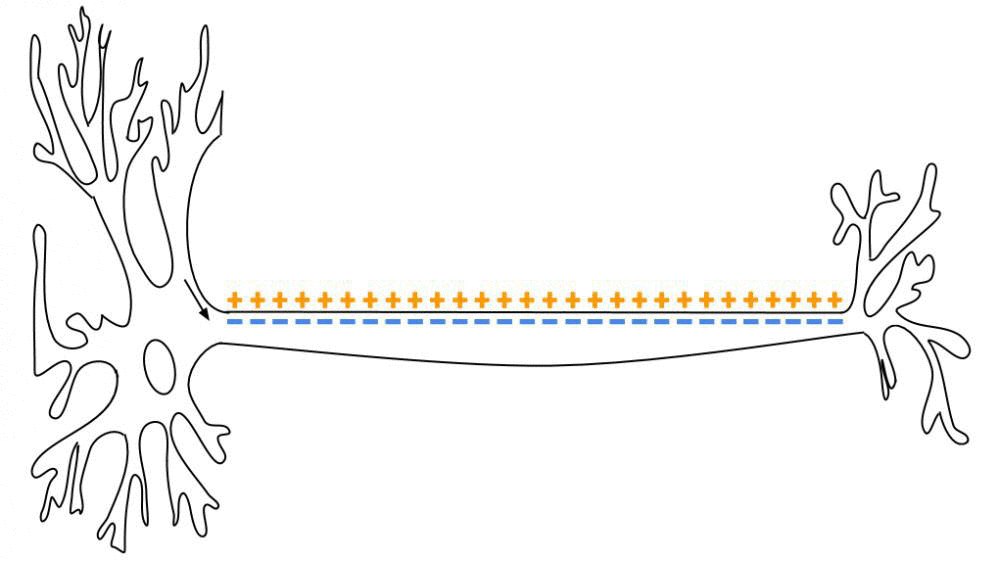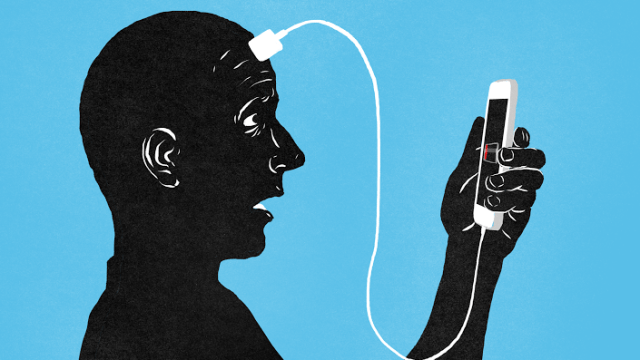Ever since Morpheus explained how the machines use humans as batteries in The Matrix, we’ve been fascinated by the idea. But can the human body actually generate enough current to do anything useful? We decided to find out, by asking experts how long it would take a human brain to charge an iPhone.
Before we attempt to answer this pressing question, a few disclaimers. 1) We’re not really living in the Matrix. 2) While the human brain produces electricity all the time, there is no known way for us to harness it. We’d be much better off trying to human-power our devices through exercise, or by capturing our waste heat. But brains are a tad more interesting, doncha think? 3) The human brain is incredibly an complicated, poorly understood machine, and the numbers I’m presenting here should be taken as very rough estimates.
Now that we’ve gotten the fine print out of the way, let’s find out whether our brains measure up to a wall charger.
What is Electricity?
When we think electricity, we think lightning bolts, power cables, generators. But these are just a few examples of a natural phenomenon that’s happening all around us, all the time. Electricity is simply the flow of electric charge across a gradient. In our computers and phones, copper wires shift electrons around. In living organisms, charge gradients across membranes produce electricity in the form of flowing ions. The processes that produce electricity are actually pretty diverse, but the result is always the same: Power. When we plug our devices into the wall, the flow of electrons causes their displays to light up and allows commands to be processed. When our neurons fire, electrical impulses cause us to dream, laugh, think, see, and move.

How Do We Measure It?
There are a couple different terms that get thrown around a lot when we talk about electricity. Here’s a brief definition of each.
Voltage: Voltage is the pressure, or force of electricity. One volt (V) is defined as the energy consumption of one joule (J) per electric charge of one coulomb (C).
Amperage: Current, also known as amperage (A), is a measure of the amount of electricity that flows through an electric circuit per second. One amp is defined as a coulomb per second.
Watts: Wattage, or power, is a measure of the work that electricity performs, or the energy output per unit time. One watt (W) is defined as one joule of energy per second.
And they’re all related! : Voltage (J/C) x Amps (C/second) = Watts (J/second)
Human Electricity, Really?
Yes, for real! Electricity is found throughout the human body. The flow of charged ions causes your heart to beat and your muscles to contract. But nowhere in the body is electrical activity better documented than the brain, which contains roughly a hundred billion electrically conductive, biological wires.
Here’s a great video that explains how electricity is produced in the human body:
How Much Juice?
In our brains, electrical signals are propagated through neurons following action potentials — brief pulses in which the charge gradient across the cell membrane flips. Here’s what that looks like:

An action potential pulsing across a neuron leads to the flow of electric current. Image via Wikipedia
The average mammalian neuron has a ‘resting potential’ of about -65 millivolts (mV). After being stimulated, the cell membrane depolarizes (the charge difference becomes closer to zero.) If the stimulus raises the membrane potential above -55 mV (call the threshold potential), an action potential is triggered. The membrane potential shoots up to a peak of approximately 40 mV and quickly falls again. When this happens, electric current is propagated forward.
So, every time one of our neurons fires, it produces a charge gradient of about 105 mV (the net change between resting potential and peak.) This tiny change in voltage causes an even tinier amount of current to flow — about 1 nanoamp, or 0.000000001 amps, according to biophysicist Bertil Hille of the University of Washington.
You may be thinking these numbers sound pretty puny. But lucky for us, the human brain contains roughly 80 billion neurons. Of course, not all of them are lighting up at once. In fact, recent research suggests that only about one per cent of the neurons in our brains are active at any given moment. Still, 800 million neurons is nothing to sniff at — it might just be enough to produce a meaningful amount of power. Let’s do the maths and see.
Given: 105 mV per action potential, 1 nanoamp of current per neuron, and 800 million neurons firing at once, how long would it take my brain’s electricity to charge an iPhone?
First, we’ll convert everything to fundamental units:
1 nanoamp / neuron = 1.0 x 10^-9 amperes / neuron
105 mV / action potential = 0.105 V / action potential
Next, we’ll calculate the amount of power generated when a single neuron fires:
0.105 V x (1.0 x 10^-9 A) = 1.05 x 10^-10 W / neuron
Scaling up to an entire human brain:
(1.05 x 10^-10 W / neuron) x (800 million neurons / brain) = 0.085 Watts / brain
Now we’re getting somewhere! On average, at any given moment, your brain’s electricity is outputting roughly 0.085 Watts of power. Your brain is basically an energy saving LED.
I have an iPhone 5C, whose battery claims to hold a charge of 5.74 Watt hours. So, how much time would it take my brain’s electricity to charge my phone?
5.74 Watt hours / 0.085 Watts = 68.33 hours
There you have it, folks: If you could somehow divert every single biological wire in your skull to your iPhone’s battery, you’d be fully charged in just under seventy hours! Huh! That doesn’t sound particularly efficient, especially when compared to a standard wall charger, which usually does the trick in under an seventy minutes.
And of course, diverting all of your brain’s electricity somewhere else would leave precious little juice other important stuff, to wit, breathing. If we want to be conservative, we could say it’s probably only safe to divert 1% of your brain’s electricity at a time, in which case it’d take 6,833 hours, or 285 days, to charge your phone.
I’m starting to think that this harebrained idea should probably be shelved, unless we face an energy apocalypse of cataclysmic proportions. In which case, charging your phone will probably rank lower on your list of worries than fending off hordes of anemic, cannibalistic, mace-toting road warriors.
Now if you’ll excuse me, I’ve gotta figure out how to hook up my brain to the generator in my energy apocalypse bunker.
Top illustration by Jim Cooke
